Salmon is one of the most popular and nutritious fish in the world. It is rich in protein, omega-3 fatty acids, and vitamin D. However, salmon is also highly perishable and can spoil quickly if not stored properly. In this article, we will answer some common questions about salmon refrigeration, such as:
- How long can salmon stay fresh in the fridge?
- How can you tell if salmon is bad or spoiled?
- How can you store salmon safely and extend its shelf life?
- What are the best ways to cook and serve salmon?
By following the tips and advice in this article, you will be able to enjoy fresh and delicious salmon without risking food poisoning or wasting money.
How Long Can Salmon Stay Fresh in the Fridge?
The answer to this question depends on several factors, such as:
- The type of salmon (fresh, frozen, smoked, canned, etc.)
- The date of purchase or catch
- The temperature and humidity of the fridge
- The packaging and wrapping of the salmon
As a general rule of thumb, fresh or thawed salmon can last for up to two days in the fridge, while smoked or canned salmon can last for up to a week. However, these are only estimates and may vary depending on the specific conditions of your fridge and salmon.
To be on the safe side, it is best to check the expiration date or sell-by date on the package of the salmon before buying or storing it. If there is no date on the package, you can ask the seller or use your senses to judge the freshness of the salmon.
How Can You Tell If Salmon Is Bad or Spoiled?
Salmon is a delicate fish that can go bad easily if not handled or stored properly. Eating spoiled salmon can cause food poisoning symptoms such as nausea, vomiting, diarrhea, and abdominal cramps. Therefore, it is important to know how to tell if salmon is bad or spoiled before cooking or eating it.
Here are some signs that indicate that salmon is bad or spoiled:
- The color of the salmon changes from bright pink or orange to dull gray or brown.
- The texture of the salmon becomes slimy, mushy, or flaky.
- The smell of the salmon becomes sour, fishy, or ammonia-like.
- The taste of the salmon becomes bitter, metallic, or rancid.
If you notice any of these signs, do not eat the salmon and discard it immediately. Do not try to salvage or cook spoiled salmon, as it may still contain harmful bacteria or toxins that can make you sick.
How Can You Store Salmon Safely and Extend Its Shelf Life?
Salmon is a highly perishable food that requires proper storage to prevent spoilage and contamination. Here are some tips on how to store salmon safely and extend its shelf life:
- Keep salmon refrigerated at 40°F (4°C) or below at all times. Do not leave salmon at room temperature for more than two hours, as this can increase the risk of bacterial growth and spoilage.
- Wrap salmon tightly in plastic wrap, aluminum foil, or airtight containers to prevent exposure to air and moisture. This can also prevent cross-contamination with other foods in the fridge.
- Freeze salmon if you do not plan to use it within two days. Frozen salmon can last for up to six months in the freezer without losing its quality or flavor. However, make sure to thaw frozen salmon in the fridge overnight before cooking it. Do not refreeze thawed salmon, as this can affect its texture and taste.
- Label and date your salmon packages before storing them in the fridge or freezer. This can help you keep track of how long they have been stored and avoid using expired or spoiled salmon.
What Are the Best Ways to Cook and Serve Salmon?
Salmon is a versatile fish that can be cooked and served in many different ways. Some of the most popular methods of cooking salmon are:
- Baking: Baking is a simple and healthy way to cook salmon in the oven. You can season your salmon with salt, pepper, lemon juice, herbs, spices, or sauces of your choice. Then place it in a baking dish or sheet and bake it at 375°F (190°C) for 15 to 20 minutes or until it flakes easily with a fork.
- Grilling: Grilling is a great way to add some smoky flavor and char marks to your salmon. You can marinate your salmon with oil, vinegar, soy sauce, honey, garlic, ginger, or other ingredients for at least 30 minutes before grilling. Then preheat your grill to medium-high heat and grill your salmon for 4 to 6 minutes per side or until it reaches an internal temperature of 145°F (63°C).
- Pan-frying: Pan-frying is a quick and easy way to cook salmon on the stovetop. You can coat your salmon with flour, cornmeal, breadcrumbs, or other coatings for some extra crunch. Then heat some oil or butter in a large skillet over medium-high heat and fry your salmon for 3 to 4 minutes per side or until golden and crisp.
- Poaching: Poaching is a gentle and moist way to cook salmon in a simmering liquid. You can use water, broth, wine, milk, or juice as the poaching liquid and add some aromatics like onion, celery, carrot, bay leaf, peppercorns, or dill. Then bring the liquid to a boil and reduce the heat to a simmer. Add your salmon and cook it for 10 to 15 minutes or until it flakes easily with a fork.
You can serve your cooked salmon with various side dishes, such as rice, potatoes, salad, vegetables, bread, or pasta. You can also drizzle some sauce or dressing over your salmon, such as lemon butter, tartar sauce, pesto, salsa, or yogurt.
FAQ
Here are some common questions and answers about salmon refrigeration that you may find helpful.
How long is salmon good for in the refrigerator?
The answer to this question depends on the type and quality of the salmon, as well as the temperature and humidity of the refrigerator. According to some online sources, fresh or thawed salmon can last for up to two days in the refrigerator, while smoked or canned salmon can last for up to a week. However, these are only estimates and may vary depending on the specific conditions of your refrigerator and salmon. To be on the safe side, it is best to check the expiration date or sell-by date on the package of the salmon before buying or storing it. If there is no date on the package, you can ask the seller or use your senses to judge the freshness of the salmon.
How do I store salmon in the refrigerator?
To store salmon in the refrigerator, you need to wrap it tightly in plastic wrap, aluminum foil, or airtight containers to prevent exposure to air and moisture. This can also prevent cross-contamination with other foods in the refrigerator. You should also place the salmon on the bottom shelf of the refrigerator, where it is coldest and least likely to be affected by temperature fluctuations. You should consume the salmon within two days of purchase or catch, or freeze it if you want to extend its shelf life.
How do I freeze salmon?
To freeze salmon, you need to first rinse it with cold water and pat it dry with paper towels. Then you need to wrap it tightly in plastic wrap, aluminum foil, or freezer bags, making sure to squeeze out any air bubbles. You can also label and date your salmon packages before freezing them, so you can keep track of how long they have been frozen. You should freeze salmon as soon as possible after buying or catching it, and use it within six months for optimal quality and flavor.
How do I thaw salmon?
To thaw salmon, you need to transfer it from the freezer to the refrigerator and let it thaw overnight. This is the safest and most recommended method, as it prevents bacterial growth and preserves the texture and taste of the salmon. You should not thaw salmon at room temperature or in hot water, as this can increase the risk of spoilage and food poisoning. You should also not refreeze thawed salmon, as this can affect its quality and safety.
How do I reheat salmon?
To reheat salmon, you need to use a gentle and moist method that does not overcook or dry out the fish. Some of the best methods are:
- Microwaving: Place the salmon in a microwave-safe dish and cover it with a damp paper towel. Microwave it on low power for 1 to 2 minutes or until it reaches an internal temperature of 145°F (63°C). Check and flip the salmon halfway through for even heating.
- Steaming: Fill a pot with water and bring it to a boil. Place the salmon in a steamer basket or colander over the pot and cover it with a lid. Steam it for 5 to 10 minutes or until it reaches an internal temperature of 145°F (63°C).
- Baking: Preheat your oven to 275°F (135°C) and line a baking sheet with parchment paper. Place the salmon on the baking sheet and cover it with aluminum foil. Bake it for 10 to 15 minutes or until it reaches an internal temperature of 145°F (63°C).
Salmon is a delicious and nutritious fish that can be enjoyed in many ways. However, it is also highly perishable and can spoil quickly if not stored properly. To keep your salmon fresh and safe to eat, you need to follow some basic guidelines on how to store, refrigerate, and freeze it.
You also need to know how to tell if salmon is bad or spoiled and how to discard it safely. By following the tips and advice in this article, you will be able to enjoy fresh and tasty salmon without risking food poisoning or wasting money.







